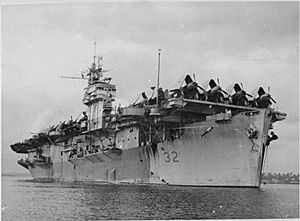Convoy JW 57 facts for kids
Convoy JW 57 was a group of ships that sailed together for safety during World War II. This particular convoy was part of the Arctic convoys, which were sent by the Western Allies (like Britain) to help the Soviet Union. It sailed in February 1944, carrying important supplies to the Soviet northern ports. Amazingly, all the merchant ships in this convoy reached their destination safely!
However, the journey was not easy. For several days, Convoy JW 57 was attacked by German U-boats (submarines). During these attacks, one Allied escort ship was sunk. But the Allied forces fought back, destroying two German U-boats.
Contents
What Was Convoy JW 57?
Convoy JW 57 was a large group of 45 merchant ships. These ships were carrying vital supplies, like food, weapons, and raw materials, to the Soviet Union. They left Loch Ewe in Scotland on February 20, 1944.
Who Protected the Convoy?
To keep the merchant ships safe, a strong group of warships sailed with them. This protection included:
- Close Escort: A group of ships that stayed very near the convoy. This included the destroyer Keppel (led by Commander IJ Tyson), three other destroyers, and four smaller warships called corvettes.
- Ocean Escort: A larger group of warships that provided wider protection. This force had 14 destroyers and the cruiser Black Prince (led by Vice Admiral IG Glennie).
- Air Support: The escort carrier Chaser also joined the convoy. Escort carriers were smaller aircraft carriers that carried planes to spot U-boats and attack them from the air. Chaser had two destroyers and two frigates protecting her.
- Local Escorts: At the start and end of the journey, local escort groups from Britain and later from Murmansk (in the Soviet Union) helped guide the convoy.
- Cruiser Cover: Two cruisers, Berwick and Jamaica, followed the convoy. Their job was to guard against attacks from any smaller German surface ships. At this time, Germany's biggest warship in the Arctic, the battleship Tirpitz, was not able to fight.
German U-boat Threat
The Germans knew about the convoy and sent a force of 14 U-boats to attack it. These U-boats were arranged in two patrol lines, code-named Werewolf and Hartmut, waiting for the convoy to pass.
The Journey and Battles
Convoy JW 57 began its journey from Loch Ewe on February 20, 1944. It was first joined by a local escort, including the minesweeper Rattlesnake. The close escort ships joined them on the same day.
On February 22, the larger Ocean escort, along with Chaser and her group, met the convoy. The local escort then returned to port.
First Contact and Counter-Attack
On February 23, a German reconnaissance aircraft spotted the convoy. Planes from Chaser, called Martlets, quickly attacked the German aircraft.
The next day, February 24, the German U-boats finally found the convoy. They tried to attack but were not successful. In a strong counter-attack, the destroyer Keppel, helped by a Swordfish plane from Chaser, sank the German submarine U-713.
Losses and Victories
On February 25, the U-boats attacked again. This time, the German submarine U-990 fired a torpedo that hit the British destroyer Mahratta. The Mahratta sank very quickly, and sadly, most of her crew were lost. Only 17 sailors survived.
However, the Allies also had another success on February 25. A Catalina patrol plane, flying from Sullom Voe, found and destroyed the German submarine U-601.
After these intense battles, there were no more losses for the convoy. Convoy JW 57 reached Kola in the Soviet Union safely on February 28.
A Successful Mission
In the end, all 45 merchant ships of Convoy JW 57 arrived safely in the Soviet Union. This was a great success, especially because the German U-boats had tried so hard to stop them. Two German U-boats were destroyed during the operation.
However, the victory was also sad because of the loss of Mahratta and most of her crew. This loss was deeply felt by the sailors who had protected the convoy.


